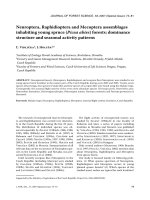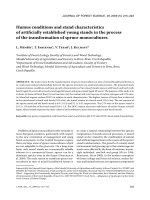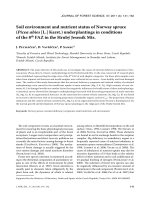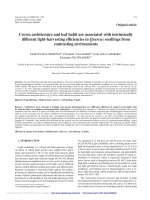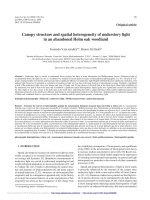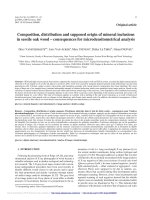Báo cáo lâm nghiệp:" Foliar N and P resorption and nutrient levels along an elevational gradient in Juniperus oxycedrus L. subsp. " pot
Bạn đang xem bản rút gọn của tài liệu. Xem và tải ngay bản đầy đủ của tài liệu tại đây (104.31 KB, 6 trang )
449
Ann. For. Sci. 60 (2003) 449–454
© INRA, EDP Sciences, 2003
DOI: 10.1051/forest:2003037
Original article
Foliar N and P resorption and nutrient levels along an elevational
gradient in Juniperus oxycedrus L. subsp. macrocarpa
(Sibth. & Sm.) Ball
Hamdi Güray KUTBAY
a
*, Tolga OK
b
a
University of Ondokuz Mayis, Faculty of Science and Arts, Department of Biology, 55139, Kurupelit-Samsun, Turkey
b
University of Sütçü mam, Faculty of Forestry, 46060, Kahramanmaraç, Turkey
(Received 23 November 2001; accepted 19 November 2002)
Abstract – Juniperus oxycedrus L. subsp. macrocarpa (Sibth. & Sm.) Ball occurs in the Mediterranean region, on the southern part of Turkey
and has been widely used in landscape planning and stabilization of coastal dunes. In this study foliar N and P resorption and foliar N, P and
K concentrations (on a leaf mass basis) were investigated in J. oxycedrus subsp. macrocarpa. Foliar N, P, and K concentrations and absolute
and proportional N and P resorption rates along the topographic position were not changed significantly. Significant correlations were found
between absolute and proportional P resorption rates and soil moisture status. However, there were no significant correlation between absolute
and proportional N resorption rates and soil moisture status. Foliar N and proportional N resorption were significantly correlated although
absolute N resorption was not significantly correlated with foliar N. However, foliar P was significantly correlated both absolute and
proportional P resorption.
Juniperus oxycedrus L. subsp. macrocarpa (Sibth. & Sm.) Ball / absolute N and P resorption / proportional N and P resorption /
Cupressaceae / soil moisture status
Résumé – Résorption foliaire de N, P et niveaux de nutrition chez Juniperus oxycedrus L. ssp. macrocarpa (Sibth. & Sm.) Ball le long
d’un gradient altitudinal. Juniperus oxycedrus L. ssp. macrocarpa (Sibth. & Sm.) se rencontre en région méditerranéenne dans le Sud de la
Turquie. Il a été largement utilisé pour la stabilisation de dunes côtières et pour l’urbanisation. Dans ce travail, on a étudié chez cette espèce la
résorption foliaire de N et P et les concentrations foliaires en N, P et K. Les concentrations foliaires en N, P et K et les taux de résorption (valeurs
absolues et relatives) ne varient pas de façon significative avec la position topographique. Des corrélations significatives ont été trouvées entres
les valeurs de résorption de P et l’humidité des sols. Cependant, il n’y a pas de corrélation significative entre les taux de résorption de N (valeurs
absolues et relatives) et l’humidité des sols. La concentration foliaire en N et la résorption foliaire en N (valeurs relatives) étaient corrélées
significativement bien que la résorption de N en valeurs absolues n’était pas corrélée avec la concentration foliaire en N. Pourtant les
concentrations foliaires en P étaient significativement corrélées avec les résorptions de P (valeurs absolues et relatives).
Juniperus oxycedrus L. ssp. macrocarpa (Sibth. & Sm.) Ball / résorption de N et P / humidité du sol / Cupressacée
I
·
1. INTRODUCTION
Concentrations of nutrients in mature leaves can indicate
the nutritional status of a plant. For this reason, foliar analysis
is a classic tool for diagnosing nutrient efficiencies and has
long been applied to forests. Forest trees, shrubs and herbs
retranslocate sizeable proportions of the nutrient content of
leaves before leaf abscission. Retranslocation increases the
control of the individual plant over the nutrient resources and
it has acquired and allows the plant to reutilize them [30, 43].
One of the most important method to measure of nutrient use
efficiency in plants is to determine foliar resorption, the proc-
ess of nutrient translocation from the leaves into storage tis-
sues during senescence [24, 27]. Oleksyn et al. [33] concluded
that intraspecific genetic differences exist in foliage nutrient
concentrations among diverse populations and as a result of
interactions between temperature, litter quality and its miner-
alization, a tendency toward higher foliage concentrations of
macronutrients can be an adaptive feature enhancing plants
metabolic activity in their native habitats. Foliar resorption,
can potentially supply the major part of the amounts needed in
production of new foliage in the following year and such a
conservative behavior leads to a tight circulation in the ecosys-
tem [46].
It has been reported that individuals growing in less fertile
sites may use nutrients more efficiently than those growing in
* Corresponding author:
s
450 H.G. Kutbay, T. Ok
more fertile sites. However, some stress factors such as low
soil moisture may reduce resorption, especially of nitrogen.
Several studies examining foliar nutrient resorption among
temperate deciduous stands support these hypotheses for
nitrogen and phosphorus [8, 19, 31].
Whittaker [47] showed that nutrients vary with topographic
position within a forest. Because of this, the examination of
nutrient dynamics along interstand topographic gradients may
be used to examine hypotheses relating fertility to nutrient
content [18].
Juniperus oxycedrus L. subsp. macrocarpa (Sibth. & Sm.)
Ball is a coniferous plant belonging to Cupressaceae. It is dis-
tinguished from related subspecies Juniperus oxycedrus L.
subsp. oxycedrus with its longer and hard textured leaves and
bigger cones [5]. This subspecies is rare in Turkey as com-
pared to other coniferous species. It is also distributed in the
Mediterranean region from Spain to Greece and in north-west
Africa outside Turkey [12]. It is a shrub like plant and 2–3 m.
in height, however it can be reached up to 6–7 m and female
flowers have a quite decorative feature. So that it can be used
widely in landscape planning [6]. It can also be used for stabi-
lizing of sand dunes due to its dense root system and very
resistant to salt spray. J. oxycedrus subsp. macrocarpa should
be protected because this subspecies is very rarely occured in
Turkey and the other Mediterranean countries. Except the
study area the individuals of this subspecies are rather scat-
tered [12].
In this study nitrogen (N), phosphorus (P) and potassium
(K) concentrations (g/kg) in mature and fresh-litter leaves and
absolute and proportional N and P resorption leaves of J. oxyc-
edrus subsp. macrocarpa along a topographic position were
investigated. This subspecies was chosen because it was
occured along the entire topographic gradient. This study has
two main objectives: (a) to investigate whether absolute and
proportional foliar N and P and soil parameters were changed
along the topographic position and, (b) to examine the factors
which effective on absolute and proportional foliar N and
P resorption.
2. MATERIALS AND METHODS
2.1. The study area and the collection of samples
J. oxycedrus subsp. macrocarpa specimens were collected from
Tav¸sanburnu locality near the Didim town (Aydin; 37° E , 28°
N)
which is situated on the southwest part of Turkey. The canopy
individuals were 15 years of age and had no obvious sign of damage
[12]. In this area the individuals of this subspecies are very
widespread. Mean annual temperature in the study area is 17.6 °C.
Mean annual precipitation is 1001.7 mm. Maximum temperature for
the hottest month; July (M) is 33.8
°C and minimum temperature for
the coldest month; January (m) is 4.8
°C. Pluviometric quotient (Q) is
73. Mean annual relative humidity and relative humidity in summer
are 62% and 51%, respectively. According to these data Central
Mediterranean climate is seen in the study area by the method of
Emberger [15]. The study area is located at C1 square based on the
grid systeme of Davis [16].
20 ´ 20 m plots was sampled along topographic position from 10
to 200 m (10, 50, 150 and 200 m) from the sea level. Plots were
selected to have closed tree canopies on southwest facing slopes.
From each topographic position five J. oxycedrus subsp. macrocarpa
individuals (³ 4.5 m tall) were randomly selected and flagged.
Individuals were selected ³ 3 m from the stems of neighboring
canopy trees to avoid potential microsite variation [11]. The
coniferous species experiences strong increases in the nitrogen
concentrations per needle in the successive growing seasons, hence
the proportion of the total concentration reached during the needles’s
first months of life is considerably smaller [19], since five fresh
leaves from throughout the midcrown per individual were taken to
avoid effects of crown position in mature (mid-growing season)
leaves (at the first half of August 1998). Freshly abscissed litter (five
leaves) was also collected under each individual at the first half of
May.
From each topographic position five soil samples were taken at a
depth of 35 cm with a soil corer. Each sample from each topographic
position was a composite of five subsamples collected at random
beneath the plant specimens. The samples were brought to the
laboratory in polyethylene bags. Soil samples were air-dried and
sieved to pass through a 2 mm mesh prior to analysis. Because soil
parameters changed very little during both sampling period soil
samples belonging to both sampling period were pooled.
2.2. Methods of chemical analysis
Leaf samples were dried at 70
°C
until constant weight, ground,
and sieved and digested in a mixture of nitric and perchloric acids
with the exception of samples for N analysis. Nitrogen was deter-
mined by the micro Kjeldahl method with a Kjeltec Auto 1030 Ana-
lyser (Tecator, Sweden) after digesting the samples in concentrated
H
2
SO
4
with a selenium catalyst. P was determined with stannous
chloride method by using a Jenway spectrophotometer. K was deter-
mined by Petracourt PFP-7 flame photometer [3]. Very similar N
indices of retranslocation were obtained using either leaf area or per-
centage content as the basis for calculation in different Mediterranean
evergreens [37, 39]. So nutrient concentrations in mature leaves were
expressed on a leaf mass basis (g/kg). Absolute resorption was calcu-
lated as the difference between the concentration of mature leaves
and fresh litter foliar concentration. Proportional resorption was
found by dividing the absolute resorption by the nutrient concentra-
tion in mature leaves. The proportional resorption is thus the propor-
tion of nutrient concentration in a mature leaf that is removed from
the leaf before it is shed [32, 34, 35, 40, 42]. Resorption estimation
was not derived for K because it is easily leached from senescing
leaves [44]. Leaching experiments indicated that less than 1 g/kg of
the autumnal reductions of N and P could have been due to leaching
of foliage by precipitation [24]. Chapin and Kedrowski [14] indicated
that leaching was much less important than retranslocation in remov-
ing nutrients from senescing leaves. So that potential N and P losses
due to leaching was not measured.
Soil texture was determined by the Bouyoucus hydrometer
method. pH values were measured in deionized water (1:1). Soil nitro-
gen (g/kg) was determined by the micro Kjeldahl method. Soil phos-
phorus (g/kg) was determined spectrophotometrically following the
extraction by ammonium acetate. Soil potassium (g/kg) was deter-
mined by using a Petracourt PFP-7 flame photometer after nitric acid
wet digestion. Organic matter (g/kg) concentration was determined by
Walkley-Black method [7]. For the determination of soil moisture
(cm
3
H
2
O/100 cm
3
soil) about 250–300 g samples were placed in soil
pins, weighed fresh, dried at 105 °C for 48 h, then weighed dry and
then soil moisture was calculated on a volume basis [9]. The results
of soil analysis were explained according to Bayraklý [7].
One and two-way analysis of variance (ANOVA) tests and Pear-
son correlation coefficients were carried out by using MINITAB [4,
38]. Tukey’s honestly significant difference (HSD) test was used to
rank means following analysis of variance.
Foliar N and P resorption in Juniperus oxycedrus 451
3. RESULTS
N foliar concentrations in mature leaves ranged from 5.38–
14.00 (g/kg). Fresh litter N concentrations ranged from 2.90–
10.10 (g/kg). Mature and fresh litter P foliar concentrations
ranged from 0.09–0.30 and 0.02–0.07 (g/kg), respectively. For
K foliar concentrations the values were ranged from 0.23–0.53
and 0.03–0.32 (g/kg), respectively (Tabs. I and II).
Nutrient concentrations were significantly decreased in
fresh litter leaf samples (Tab. III).
Statistical assesment of proportional and absolute resorp-
tion rates showed that foliar N and P proportional and absolute
resorption rates did not change significantly along topographic
positions (Tabs. IV and V).
The soils under J. oxycedrus subsp. macrocarpa were clay-
loam with 378.4 g/kg clay content. Soil N concentrations were
high (Tab. VI). However, soil K concentrations were low to
medium levels. Soil P concentrations were low especially in
valley positions, however these values increased in slope posi-
tions. J. oxycedrus subsp. macrocarpa occur on neutral soils
with respect to pH values. Organic matter values were low in
valley positions. However, there was a sharp increase at 50 m.
After that organic matter concentrations were decreased, how-
ever slope and upper positions are still rich in organic matter.
Table I . Foliar nutrient concentrations in mature leaves (g/kg). Standard errors are given in parenthesis.
Nutrient Valley
°
Slope
°°
Slope
°°°
Upland
°°°°
F-value Probability Significance
N 10.8 (1.78) 9.8 (0.81) 6.4 (0.56) 8.2 (0.81) 3.079 0.090 NS
P 0.16 (0.04) 0.15 (0.06) 0.13 (0.07) 0.28 (0.002) 1.515 0.283 NS
K 0.40 (0.06) 0.26 (0.02) 0.23 (0.04) 0.26 (0.003) 3.198 0.084 NS
°10 m, °°50 m, °°°150 m, °°°°200 m.
NS: not significant.
Tab le II. Fresh litter foliar nutrient concentrations (g/kg). Standard errors are given in parenthesis.
Nutrient Valley
°
Slope
°°
Slope
°°°
Upland
°°°°
F-value Probability Significance
N 7.38 (2.16) 7.01 (1.95) 2.96 (0.006) 4.98 (1.98) 1.334 0.330 NS
P 0.004 (0.006) 0.004 (0.006) 0.004 (0.02) 0.006 (0.006) 1.242 0.357 NS
K0.005
(0.002) 0.51 (0.21) 0.48 (0.13
) 0.27 (0.05) 2.810 0.108 NS
°10 m, °°50 m, °°°150 m, °°°°200 m.
NS: not significant.
Table III. The differences between mature and fresh leaf litter foliar
nutrient concentrations.
Nutrient F-value Probability Significance
N 8.064 0.010 **
P 20.450 0.002 **
K 11.112 0.003 **
** P < 0.01.
Table IV. Proportional resorption rates (%) along the topographic position. Standard errors are given in parenthesis.
Nutrient Valley Slope Slope Upland F-value Probability Significance
N (%) 34.7 (13.32) 31.4 (16.05) 53.0 (3.49) 41.9 (18.11) 3.481 0.709 NS
P (%) 70.8 (4.16) 54.1 (19.38) 63.8 (7.34) 77.4 (0.95) 1.024 0.432 NS
NS: not significant.
Table V. Absolute resorption rates (g/kg) along the topographic position. Standard errors are given in parenthesis.
Nutrient Valley Slope Slope Upland F-value Probability Significance
N 3.3 (0.91) 2.8 (1.24) 3.4 (0.49) 3.2 (1.40) 0.063 0.978 NS
P 0.11 (0.03) 0.10 (0.06) 0.009 (0.06) 0.2 (0.01) 1.405 0.310 NS
NS: not significant.
452 H.G. Kutbay, T. Ok
There were significant differences along the topographic posi-
tion in respect to N, P, K and soil moisture (Tab. VI).
Significant correlations were found between foliar N and
P concentrations and absolute and proportional resorption
rates and resorption rates and soil moisture (Tab. VII).
4. DISCUSSION
It has been found that foliar N was not changed signifi-
cantly among topographic positions. The lack of significant
differences in foliar N among topographic positions may have
resulted from carbon dilution effect or luxury consumption
[18]. The lack of significant differences may also reflect the
narrower intrastand fertility gradients among topographic
positions due to narrow distribution of this subspecies [19].
N concentration values of J. oxycedrus subsp. macrocarpa
are within the ranges reported for the other evergreen conifer-
ous species (Tab. I) as reported by Schulze et al. [40].
Aerts [1] reported that mean nutrient proportional resorp-
tion rate was 47% for N and 50% for P in evergreen species.
Proportional N resorption rates in the present study were con-
sistently lower than in other studies except for the slope topo-
graphic positions (150 m). For example, Boerner [8] and Cote
et al. [10] reported a range of 26.5–63.7 and 56–71% N resorp-
tion, respectively in deciduous forests. Chapin & Kedrowski
[14] indicated that high concentrations of phenolics especially
in evergreen leaves, as observed in low-productivity species
growing at infertile sites may lead to precipitation of proteins
before protein hydrolysis, which reduces nutrient resorption.
Valley topographic positions in the study area were usually
infertile and proportional N resorption rates in valley positions
were low as compared to the other topographic positions
(Tabs. IV and VI).
However, P resorption rates were usually within the ranges
reported by Killingbeck and Costigan [24] for several species.
Proportional P resorption in the present study was particularly
high especially at valley and upland sites (Tab. IV) and
exceeded the values reported by Aerts [1] and similar to Cote
et al. [10]. However, proportional N resorption values at valley
and upland sites were lower than that of the values reported by
Aerts (1996) although proportional N resorption was within
the average values (Tab. IV) reported by Aerts [1].
De Mars and Boerner [18] stated that both absolute and pro-
portional P resorption were significantly greater in the valley
topographic positions where soil P was lowest. However, in
the present study, absolute and proportional P resorption was
higher in the upland topographic positions (Tabs. IV and V).
It can be argued that individuals growing on nutrient-rich
sites may have larger absolute and proportional retransloca-
tion of foliar nutrients, since their mature leaves are likely to
have higher concentrations of nutrients, of which a greater
proportion are in hydrolyzable forms [30]. However, a consist-
ent pattern was not found with respect to N and P resorption
rates in the present study (Tabs. IV and V). Aerts [1] indicated
that nutrient resorption was not very responsive to increased
nutrient availability. The lack of significant differences in
N resorption rates may simply result from the fact that foliar
N levels were not significantly different among topographic
positions [18]. N proportional resorption was greater in the
slope and upper topographic positions (150–200 m) where soil
Table VI. Mean values for soil paremeters along the topographic position and the comparison of soil parameters by one-way ANOVA test.
Standard errors are given in parenthesis. Means followed by the same letter are not significantly different at the 0.05 level using Tukey’s HSD
test.
Soil parameter Valley Slope Slope Upland F-value Probability Significance
N (g/kg) 0.26 (0.05)a 0.63 (0.02)b 0.51 (0.01)b 0.29 (0.01)a 41.010 0.001 **
P (g/kg) 0.008 (0.33 ´ 10
–3
)a 0.007 (0.001)a 0.012 (0.03)a 0.020 (0.003)b 12.088 0.001 **
K (g/kg) 0.004 (1.00 ´ 10
–3
)a 0.51 (0.21)a 0.48 (0.13)a 0.27 (0.05)a 6.354 0.008 **
pH 7.33 (0.04)a 7.40 (0.08)a 7.33 (0.11)a 7.46 (0.04)a 12.499 0.001 **
Organic matter
(g/kg)
0.99 (0.67)a 9.80 (4.94)a 2.59 (0.04)a 4.11 (0.74)a 26.724 0.000 **
Moisture cm
3
H
2
O/100 cm
3
soil
47 (3.66)a 88 (11.33)b 62 (3.66)a 88 (6.41)a 9.180 0.002 **
** P < 0.01.
Table VII. Pearson correlation coefficients between foliar N and P
concentrations and absolute and proportional resorption rates and
resorption rates and soil moisture.
Parameter Correlation
coefficient
Significance
Foliar N in mature leaves-absolute
N resorption
–0.252 NS
Foliar N in mature leaves-proportional
N resorption
–0.634 **
Foliar P in mature leaves-absolute P
resorption
0.737 **
Foliar P in mature leaves-proportional
P resorption
0.993 **
Absolute N resorption-Soil moisture 0.389 NS
Proportional N resorption-Soil moisture 0.260 NS
Absolute P resorption-Soil moisture –0.652 **
Proportional P resorption-Soil moisture –0.506 **
NS: not significant. ** P < 0.01.
Foliar N and P resorption in Juniperus oxycedrus 453
moisture was higher in both sampling dates as indicated by del
Arco et al. [17], Hocking [22] and Kost and Boerner [25] and
this might reflect inefficient proportional N resorption by
J. oxycedrus subsp. macrocarpa individuals in valley topo-
graphic positions (Tab. IV). There were significant correla-
tions between absolute and proportional P resorption rates and
soil moisture status (Tab. VII). However, there were no signif-
icant correlation between absolute and proportional N resorp-
tion rates and soil moisture status (Tab. VII) on the contrary to
several studies [17, 21, 24]. However, soil moisture were sig-
nificantly changed along the topographic position (Tab. VI).
There were no significant overall effects of topography on
foliar N concentration, despite significant topographic differ-
ences in mean soil N availability (Tabs. I, II and VI). These
results were contrast with the studies that have shown high
foliar N in more fertile sites [10] and studies that have shown
lower foliar N in nutrient poor sites [24, 27]. Foliar P and
K concentrations were also not exhibited significant differ-
ences in respect to topographic positions according to the
results of one-way ANOVA test (Tab. I). However, there were
significant differences between N, P and K concentrations of
mature and fresh litter leaves (Tab. III).
The differences between the present study and the other
studies with respect to foliar resorption may probably due to
the other studies were usually carried out with deciduous for-
est species. According to Chapin and Kedrowski [14] such dif-
ferences may be due to the different strategy of evergreen and
deciduous species in using of nutrients. For example, leaves
rather than stems are the major site of overwinter storage in
evergreen species [36].
It has been observed that mature and fresh litter foliar N, P
and K concentrations were significantly different. Similar
results were reported for some Quercus species [26, 28]. In
general, macroelements especially nitrogen concentration in
leaves is strongly correlated with photosynthetic capacity [36]
and it has been known that photosynthetic capacity was
decreased during senescence [20] and remobilization of min-
eral nutrients (except calcium and manganese) from leaves to
woody parts [29]. However, there was a difference between
evergreen and deciduous species in transferring of phospho-
rus. In evergreen species, the decline in P concentration was
usually due to dilution of P during senescence rather than to
P retranslocation from needles [14].
Chapin & Kedrowski [14] found a positive correlation
between the N concentration of mature leaves and N resorption
rate and they were suggested that leaf N concentration may par-
tially control leaf N retranslocation, however P retranslocation
was not controlled by leaf P concentration. Negative correla-
tion coefficients were obtained with respect to absolute and
proportional N concentrations and N concentration of mature
leaves. For example, there was a significant and negative cor-
relation between foliar N and proportional N resorption rate.
However, there were no significant correlation between
N absolute resorption rate and N concentration of mature
leaves in the present study. The strong positive correlations
were found between foliar P concentrations and absolute and
proportional P resorption rates (Tab. VII). Several other
authors were also arrived at conflicting conclusions, in both
intraspecific [41, 45] and interspecific comparisons [14, 17,
32].
It has been reported that nutrient-poor sites usually show
greater levels of nutrient retranslocation [13, 32, 46]. In addi-
tion to this, in nutrient-poor environments, species produce
relatively small amounts of litter due to low productivity and
long lifespans of the various tissues. This litter generally has
low nutrient concentrations and high concentrations of sec-
ondary compounds such as lignin and phenolics. Thus, species
from nutrient-poor environments produce litter that decom-
poses slowly and from which only low amounts of nutrients
are released. The opposite holds for species from fertile envi-
ronments. Owing to their high productivity and high tissue
turnover rates, they produce relatively large amounts of litter.
Moreover, this litter contains relatively high concentrations of
mineral nutrients and low concentrations of secondary com-
pounds. As a result, this litter decomposes relatively quickly
and releases high amounts of nutrients. Thus, in nutrient-poor
ecosystems the combination of low productivity (and thus low
litter production) and low litter decomposability may lead to a
low rate of ecosystem nutrient cycling [2]. Low fresh litter
nutrient concentrations in the present study may be explained
in this way. Soil P concentrations in valley positions were
rather low in the present study although P concentrations can
be high in upland positions and this may be caused high
P resorption rates. However, soil N concentrations were high
along the topographic position. Several studies were showed
that the relationship between retranslocation and soil fertility
was not observed in all cases [14, 17, 18, 23, 32] and nutrient
resorption probably reflected topographic differences in mois-
ture than in fertility. Thus, soil moisture was significantly
changed along the topographic position in the present study
(Tab. VI). Moreover, it was not known which factors control
nutrient resorption from senescing tissues, how this is related
to the dynamics of secondary compounds in senescing tissues,
and how these processes are reflected in litter decomposition
and nutrient release from litter [2].
It is possible to say that proportional P resorption was more
efficient in J. oxycedrus subsp. macrocarpa as compared to
the other evergreen species in the light of the data presented by
Aerts [1]. However, proportional N resorption J. oxycedrus
subsp. macrocarpa was not efficient as compared to the other
evergreen species except for slope topographic positions
(Tab. IV).
Several researches reached conflicting results with respect
to the relationships between leaf nutrient status and resorption.
Although, Aerts [1] pointed out that relations between leaf
nutrient status and leaf nutrient resorption were very weak,
Hevia et al. [21] showed such a relationship does exist, at least
for N. So that future research should be done to more precise
explanation of leaf nutrient status and leaf nutrient resorption
in deciduous and evergreen species.
REFERENCES
[1] Aerts R., Nutrient resorption from senescing leaves of perennials:
Are there general patterns? J. Ecol. 84 (1996) 597–608.
454 H.G. Kutbay, T. Ok
[2] Aerts R., Chapin F.S. III, The mineral nutrition of wild plants
revisited: A re-evolution of processes and patterns, Adv. Ecol. Res.
30 (2000) 1–67.
[3] Allen S.E., Grimshaw H.M., Parkinson J.A., Quarmby C., Roberts
J.D., Chemical Analysis, in: Chapman S.B. (Ed.), Methods in Plant
Ecology, Blackwell Scientific Publications, Oxford, 1986, pp. 411–
416.
[4] Anonymus, MINITAB Release 12.1 Minitab Inc., New York, 1998.
[5] Ansin R., Özkan Z., Flowering Plants (Woody Taxa) Karadeniz
University, Faculty of Forestry Publications, Trabzon, 1993.
[6] Atay I., Some investigations on coastal plains of Turkey, Turkish
Directorate of Forestry Güven Publications, Istanbul, 1964.
[7] Bayrakli F., Plant and soil analysis, University of Ondokuz Mayis,
Faculty of Agriculture Publications, Samsun, 1987.
[8] Boerner R.E.J., Foliar nutrient dynamics and nutrient use efficiency
of four deciduous tree species in relation to nutrient fertility, J.
Appl. Ecol. 21 (1984) 1029–1040.
[9] Boerner R.E.J., Foliar nutrient dynamics, growth and nutrient use
efficiency of Hamamelis virginiana in three forest microsites, Can.
J. Bot. 63 (1984) 1476–1481.
[10] Cote B., Fyles J.W., Djalilvand H., Increasing N and P resorption
efficiency and proficiency in northern deciduous hardwoods with
decreasing foliar N and P concentrations, Ann. For. Sci. 59 (2002)
275–281.
[11] Boerner R.E.J., Koslowsky S.D., Microsite variations in soil
chemistry and nitrogen mineralization in a beech-maple forest, Soil
Biol. Biochem. 21 (1989) 795–801.
[12] Browicz K., Juniperus oxycedrus subsp. macrocarpa (Sibth. &
Sm.) Ball. in the area of Flora of Turkey and the East Aegean
Islands, Karaca Arb. 3 (1996) 117–121.
[13] Chapin F.S., The mineral nutrition of wild plants, Ann. Rev. Ecol.
Sys. 11 (1980) 233–260.
[14] Chapin F.S., Kedrowski R.A., Seasonal changes in nitrogen and
phosphorus fractions and autumn retranslocation in evergreen and
deciduos taiga trees, Ecology 64 (1983) 376–391.
[15] Daget Ph., Le bioclimat méditerranéen : analyse des formes
climatiques par le système d’Emberger, Vegetatio 34 (1977) 87–
103.
[16] Davis P.H., Flora of Turkey and the East Aegean Islands Vol. I,
Edinburgh University Press, Edinburgh, 1965.
[17] Del Arco J.M., Escudero A., Garrido M.V.V., Effects of soil site
characteristics on nitrogen retranslocation from senescing leaves,
Ecology 72 (1991) 701–708.
[18] De Mars B.G., Boerner R.E.J., Foliar nutrient dynamics and
resorption in naturalized Lonicera maackii (Caprifoliaceae)
populations in Ohio, USA, Am. J. Bot. 84 (1997) 112–117.
[19] Escudero A., Del Arco J.M., Garrido M.V., The efficiency of
nitrogen retranslocation from leaf biomass in Quercus ilex
ecosystems, Vegetatio 99–100 (1992) 225–237.
[20] Feller U., Fischer A., Nitrogen metabolism in senescing leaves,
Crit. Rev. Plant Sci. 13 (1994) 241–273.
[21] Hevia F., Minoletti M.L., Decker K.L.M., Boerner R.E.J., Foliar
nitrogen and phosphorus dynamics of three Chilean Nothofagus
(Fagaceae) species in relation to leaf lifespan, Am. J. Bot. 86 (1999)
447–455.
[22] Hocking P.J., Effect of water stress on redistribution of nutrients
from leaflets of narrow-leaved lupin (Lupinus angustifolius L.),
Ann. Bot. 49 (1982) 541–543.
[23] Killingbeck K.T., The terminological jungle revisited: making a
case for use of the term resorption, Oikos 46 (1986) 263–264.
[24] Killingbeck K.T., Costigan S.A., Element resorption in a guild of
understory shrub species: niche differentiation and resorption
thresholds, Oikos 53 (1988) 366–374.
[25] Kost J.A., Boerner R.E.J., Foliar nutrient dynamics and nutrient use
efficiency in Cornus florida, Oecologia 66 (1985) 602–606.
[26] Knops J.M.H., Koenig W.D., Site fertility and leaf nutrients of
sympatric evergreen and deciduous species of Quercus in central
coastal California, Plant Ecol. 130 (1997) 121–131.
[27] Luken J.O., Population structure and biomass allocation of the
naturalized shrub Lonicera maackii (Rupr.) Maxim. in forest and
open habitats, Am. Mid. Nat. 119 (1988) 258–267.
[28] Kutbay H.G., Kilinç M., Sclerophylly in Quercus cerris L. var.
cerris and Phillyrea latifolia L. and edaphic relations of these
species, Vegetatio 113 (1994) 93–97.
[29] Marschner H., Mineral nutrition of higher plants, Academic Press
Limited, London, 1995.
[30] Mayor X., Rodà F., Is primary production in holm oak forests
nutrient limited?, Vegetatio 99 (1992) 209–217.
[31] Minoletti M.L., Boerner R.E.J., Drought and site fertility effects on
foliar nitrogen and phosphorus dynamics and nutrient resorption by
the forest understory shrub Viburnum acerifolium L., Am. Midl.
Nat. 131 (1994) 109–119.
[32] Mooney H.A., Rundel P.W., Nutrient relations of the evergreen
shrub, Adenostoma fascilatum, in the California chapparal, Bot.
Gaz. 140 (1979) 109–113.
[33] Oleksyn J., Reich P.B., Zytkowiak R., Karolewski P., Tjoelker
M.G., Needle nutrients in geographically diverse Pinus sylvestris L.
populations, Ann. For. Sci. 59 (2002) 1–18.
[34] Ouro G., Perez-Batallon P., Merino A., Effects of sylvicultural
practices on nutrient status in a Pinus radiata plantation: Nutrient
export by tree removal and nutrient dynamics in decomposing
logging residues, Ann. For. Sci. 58 (2001) 411–422.
[35] Ralhan P.K., Singh S.P., Dynamics of nutrients and leaf mass in
central Himalayan forest trees and shrubs, Ecology 68 (1987)
1974–1983.
[36] Reich P.B., Kloeppel B.D., Ellsworth D.S., Walters M.B., Different
photosynthesis-nitrogen relations in deciduous hardwood and
evergreen coniferous tree species, Oecologia 104 (1995) 24–30.
[37] Robert B., Caritat A., Bertoni G., Vilar L., Molinas M., Nutrient
content and seasonal fluctuations in the leaf component of coark-
oak (Quercus suber L. ) litterfall, Vegetatio 122 (1996) 29–35.
[38] Schaefer R.L., Anderson R.B., The student edition of MINITAB,
User’ s Manual, Addison Wesley Publishing Company, New York,
1989.
[39] Schlesinger W.H., DeLucia E.H., Billings W.D., Nutrient-use
efficiency of woody plants on contrasting soils in the Western Great
Basin, Nevada, Ecology 70 (1989) 105–113.
[40] Schulze E.D., Kelliher F.M., Körner C., Lloyd J., Leuning R.,
Relationships among maximum stomatal conductance, ecosystem
surface conductance, carbon assimilation rate, and plant nitrogen
nutrition: A global scaling exercise, An. Rev. Ecol. Syst. 25 (1994)
629–660.
[41] Shaver G.R., Melillo J.M., Nutrient budgets of marsh plants:
efficiency concepts and relation to availability, Ecology 68 (1994)
1491–1510.
[42] Staaf H., Plant nutrient changes in beech leaves during senescence
as influenced by site characteristics, Acta Oecol. Oecol. Plant. 3
(1982) 161–170.
[43] Tamm C.O., Determination of nutrient requirements of forest
stands, in: Romberger J.A., Mikola P. (Eds.), International Review
of Forestry Research, Academic Press, New York, 1964, pp. 115–
170.
[44] Tukey H.B. Jr., Tukey H.B., Wittwer S.H., Loss of nutrients by
foliar leaching as determined by radioisotopes, Proc. Am. Soc.
Hortic. Sci. 71 (1958) 496–506.
[45] Turner J., Olson P.R., Nitrogen relations in a Douglas-fir
plantation, Ann. Bot. (New Series) 40 (1976) 1185–1193.
[46] Vitousek P., Nutrient cycling and nutrient use efficiency, Am. Nat.
119 (1982) 553–572.
[47] Whittaker R.H., Vegetation of Great Smokey Mountains, Ecol.
Monogr. 26 (1956) 1–80.
